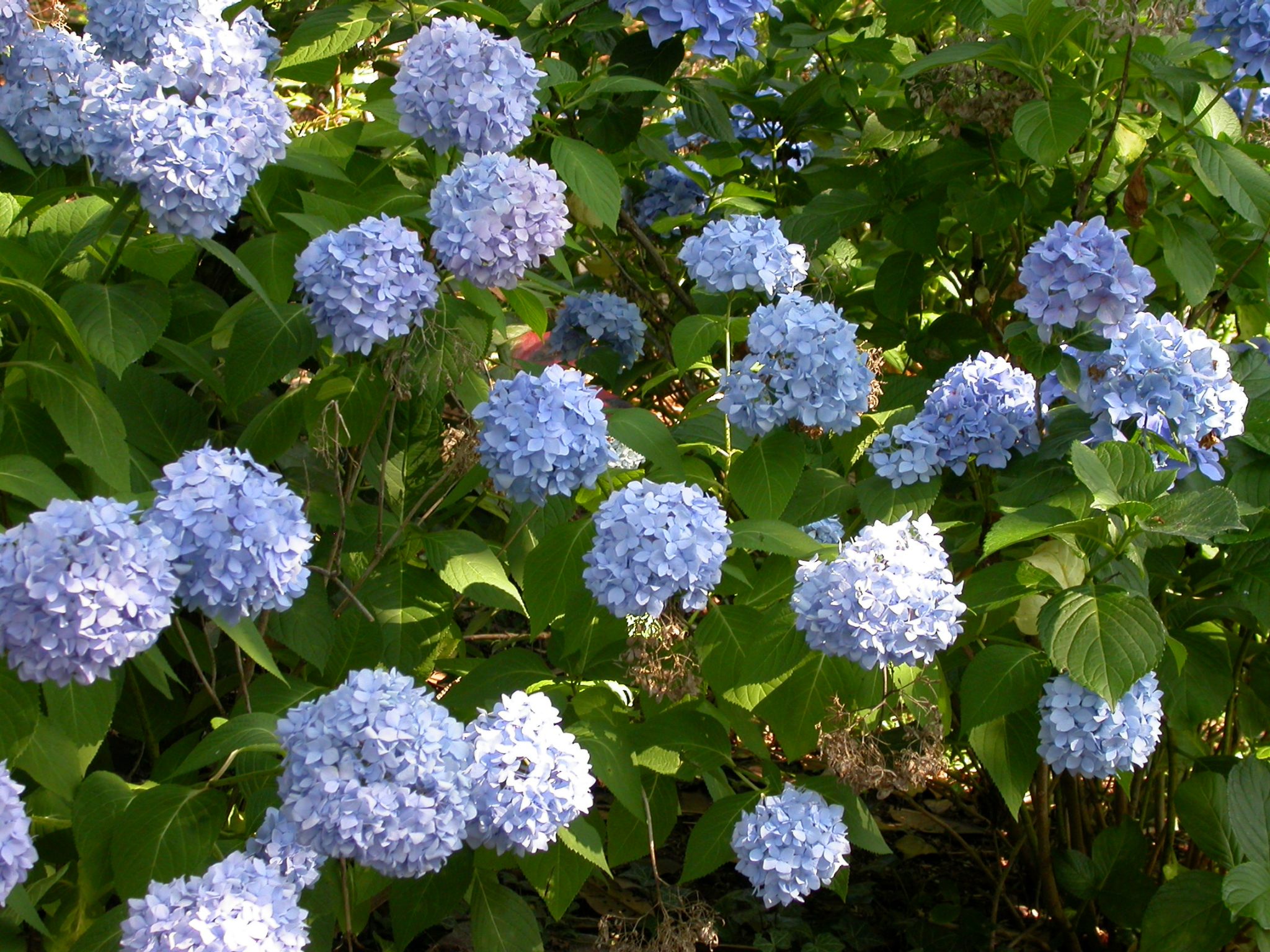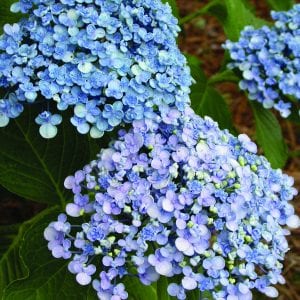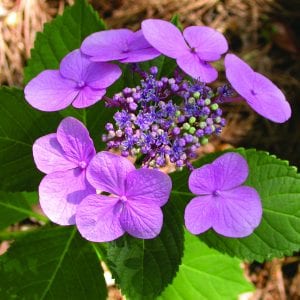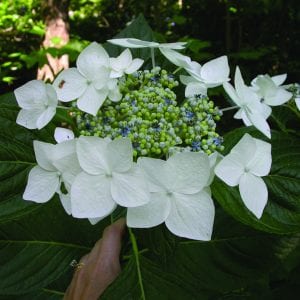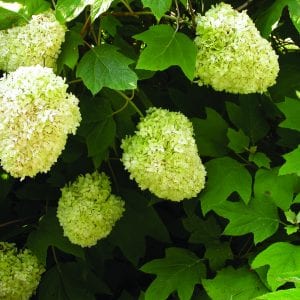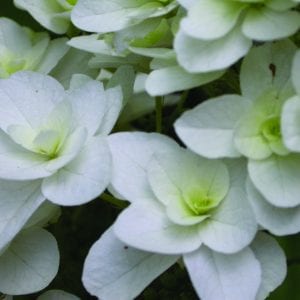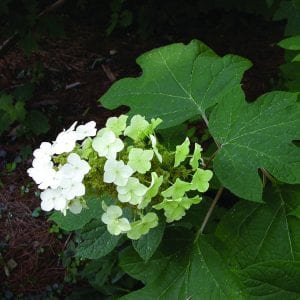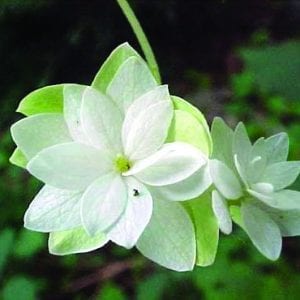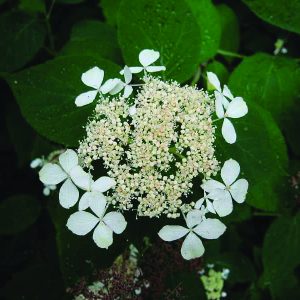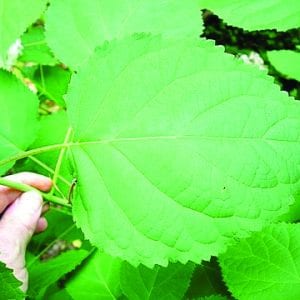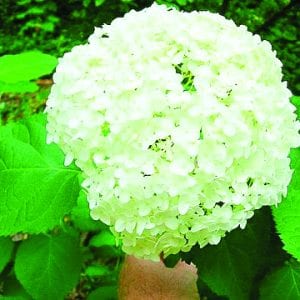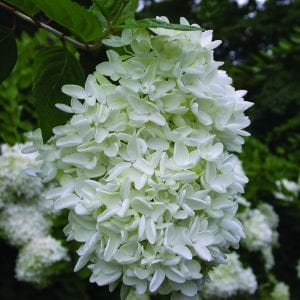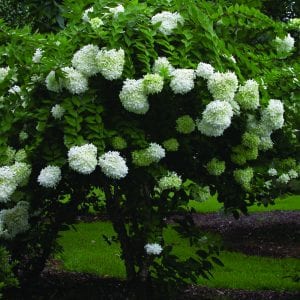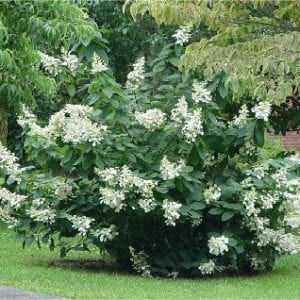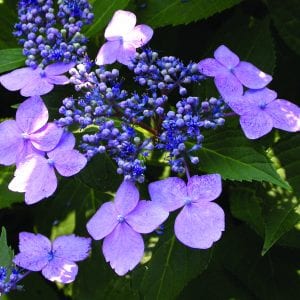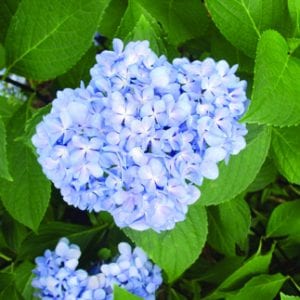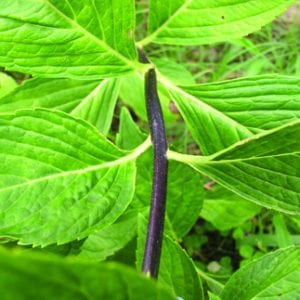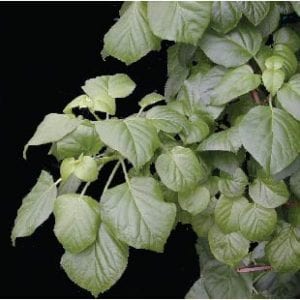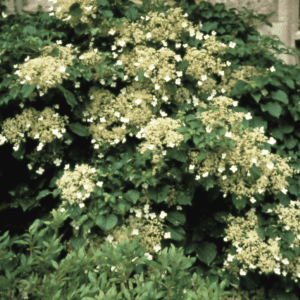Lawn & Garden

Hydrangeas, with their pink or blue cloud-shaped flowers and large, soft-green leaves, compose images of lazy summers in the shade. However, this describes only one plant, the bigleaf hydrangea, in a large and varied group. All hydrangeas are resilient and hardy plants for southern landscapes.
Most people are familiar with the large, showy pink or blue flowers of the bigleaf, or French, hydrangea, but look at the entire genus to find a variety of shrub sizes, textures, flower shapes, and colors. Although widely planted in the Southeast, hydrangeas have their origins in both southern Asia and North America. The two Alabama native species are smooth hydrangea and oakleaf hydrangea, the latter discovered by John Bartram in 1791.
Smooth hydrangea cultivars, such as ‘Annabelle’, are more easily found than the original wild species. On the other hand, oakleaf hydrangea (H. quercifolia) is easily found as either its many cultivars or the wild species. Its bold summer foliage, impressive and sometimes lacy flower clusters, fall color, and winter stem character put it in high regard for a shady shrub border.
Bigleaf hydrangea, gracing the landscapes of many homes, originally came from France by way of Japan. Bigleaf hydrangea has many common names such as snowball hydrangea, French hydrangea, common hydrangea, garden hydrangea, and hortensia. To avoid confusion, refer to the botanic name, H. macrophylla.
The lesser known hydrangeas, including serrated, panicle, and climbing, are all native to various parts of southern Asia. Serrated hydrangea (H. serrata) is similar to smooth hydrangea in its frail appearance, but don’t let that fool you. This is a very tough plant. Several cultivars of serrated hydrangea showcase the unique beauty of its flower clusters. Panicle hydrangea (H. paniculata) is a rugged, sometimes rough-looking species with several choice cultivars. Climbing hydrangea (H. anomala petiolaris) is often tricky to find in nurseries because it is difficult to propagate. It can also frustrate gardeners because of its unhurried establishment phase. Climbing hydrangea is very slow growing to start but worth the wait when you see the vine in bloom.
Note: Cultivar refers to cultivated varieties. Cultivated variety names are shown with single quotation marks, such as Hydrangea macrophylla ‘Lilacina’. The term can be abbreviated as cultivar or cv.
The Color
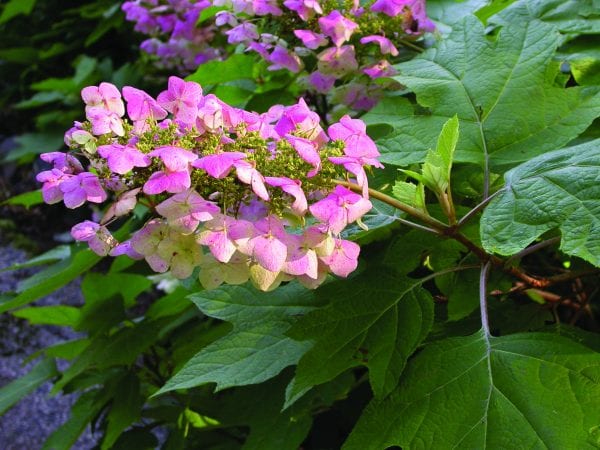 White, pink, or blue—the color is up to you. Well, not really. Gardeners only have a color choice with bigleaf and serrated hydrangeas, and several factors influence the outcome. Bloom color and intensity depend on the specific cultivar, weather, plant health, and soil. Of these, soil pH is the strongest influence gardeners can adjust. Cultivar selection and proper care and maintenance help ensure the chosen outcome.
White, pink, or blue—the color is up to you. Well, not really. Gardeners only have a color choice with bigleaf and serrated hydrangeas, and several factors influence the outcome. Bloom color and intensity depend on the specific cultivar, weather, plant health, and soil. Of these, soil pH is the strongest influence gardeners can adjust. Cultivar selection and proper care and maintenance help ensure the chosen outcome.
Blue or pink blooms depend on soil pH and corresponding available aluminum. At low pH levels (acid soils), aluminum is readily available to the plant, and flowers become blue. At high pH ranges (more alkaline soils), aluminum is less available, and flowers are pink. Want pink flowers? Add lime to raise soil pH. Want blue flowers? Add sulfur to lower soil pH.
Changing soil pH is a gradual process and requires a soil test for accuracy. If you want to experiment, try these recommendations:
Broadcast 1⁄2 cup of wettable sulfur per 10 square feet, and water into the soil to make flowers blue. For pink flowers, broadcast and water into the soil 1 cup of dolomitic lime per 10 square feet. Raising pH takes longer than lowering pH. If you want pink flowers next year, apply lime in the fall.
A faster option for changing flower color is to use liquid drenches. Want to enhance your blue flowers or change pink ones to blue? Dissolve 1 tablespoon of alum (aluminum sulfate) in a gallon of water, and drench the soil around the plant in March, April, and May. Desire pink flowers? Dissolve 1 tablespoon of hydrated lime in a gallon of water, and drench the soil around the plant in March, April, and May. Avoid splashing either of these solutions on leaves, bark, or your skin because they can burn.
Hardiness and Cold Damage
Bigleaf hydrangea is the most cold-sensitive species. It suffers with early or late freezes because the flower buds have a weak dormancy. Surprise warm weather in winter or early spring causes the buds to emerge from dormancy, grow, and become more susceptible to freeze damage. This damage results in fewer or no flowers because this year’s flower bud grows on a stem bud formed last summer.
The remedy? Site and cultivar selection. If this type of weather is common in your landscape, plant bigleaf hydrangea on northern and eastern slopes under tall pines to reduce the temperature fluctuations that cause early bud break. Or, choose resilient cultivars that either bloom later or produce new buds for the current season. (See plant descriptions that follow.)
Note: The United States Department of Agriculture Plant Hardiness Zone map indicates areas across the United States with common average minimum temperatures. Hardiness zone refers to the coldest temperature a plant can survive. A plant’s hardiness zone rating indicates locations in the United States where a plant is likely to survive year after year. (See individual plant descriptions.)
Site Selection
Hydrangeas are relatively easy to grow in well-drained soils containing plenty of organic matter. Like many southerners, they prefer warm, morning sun and cooler, afternoon shade. Avoid planting bigleaf, oakleaf, and smooth hydrangeas in hot, dry, exposed sites. Panicle hydrangea is the one species that looks better in full to part sun.
While many hydrangeas benefit from shade, planting any shrub under a large, established tree during the growing season hinders shrub establishment. Large trees require and consume enormous amounts of water in a single day. Newly planted shrubs often cannot successfully compete with them. The gardener will then find it difficult to supplement the water needs of the new shrub.
Planting
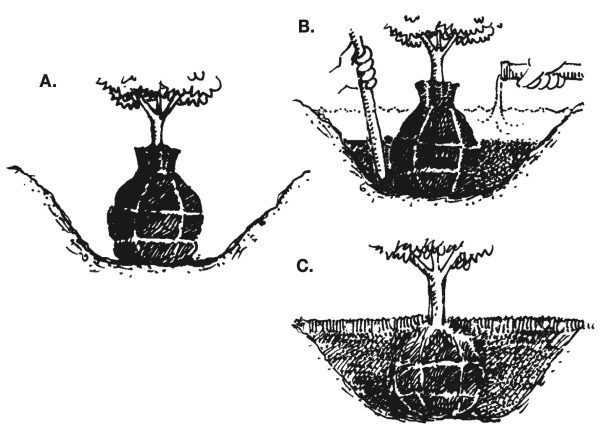
Figure 1. (A) Place plant in center of hole. (B) Fill sides one-half to two-thirds to the top of the ball and firm the soil. (C) Finish filling the hole, and cover the planting area with 2 inches of mulch.
Dig the planting hole 2 feet wider than the plant’s root ball and only as deep as the root ball itself. In heavy soils, consider preparing a planting bed instead of single planting holes. Amend any hydrangea planting with compost to create a mound. This raised planting allows better drainage for roots.
Fall planting time is best because it gives the plant several months to establish a new root system before blooming. Early spring is the next best planting time. Extra attention to watering is important if planting in summer or for any new plants in a raised planting.
Water
To look and perform their best, bigleaf and smooth hydrangeas need more water than do their relatives. Becoming tattered in appearance during periods of drought, they still survive with only minor pruning needed to restore their form. The large, soft leaves lose water quickly, and the hot sun wilts them. Even well-watered plants may appear wilted with too much sun or heat. Afternoon shade is a must for both bigleaf and smooth hydrangeas. One inch of water per week, either by rainfall or irrigation, is recommended; of course, mulching helps conserve water loss and cools the root system.
While all hydrangeas prefer consistent soil moisture, be careful not to overwater them. Oakleaf hydrangea is especially sensitive to soggy soils. Root rot on this hydrangea is a common problem in poorly drained soils or after lengthy rains. Even a large, established oakleaf colony can die from this in just a few weeks. Consider potential drainage issues at planting time and correct before a problem starts.
Fertility
Different hydrangeas have different fertility needs. Perform a soil test to best determine soil pH and nutritional requirements. Bigleaf hydrangea responds to several light fertilizer applications during the growing season. Divide soil test recommendations into three applications in March, May and June. Panicle and oakleaf hydrangeas benefit from April and June applications, while smooth hydrangea needs just one application in late winter. Do not remove mulch when fertilizing, but water at the time of application to help dissolve fertilizer.
Remember that nutrient aluminum affects flower color on bigleaf and serrated hydrangea. If you want blue flowers, use fertilizers low in phosphorus. The phosphorus level is indicated by the middle number (12-4-8) in fertilizer descriptions. Phosphorus ties up aluminum, making it unavailable for root uptake and leads to pink flowers. Note: Periodic soil tests are recommended to ensure that phosphorus levels remain at acceptable levels. Too much soil phosphorus can cause plant injury.
Pruning

Oakleaf hydrangea ‘Snowflake’
Understanding flower development for each species is helpful. Some hydrangeas bloom on “old wood” while others bloom on “new wood.” Bearing flowers on stems produced from last year’s buds describes blooms on old wood. Flower buds forming on this year’s growth appear on new wood. Prune shrubs that bloom on old wood shortly after current flowering to avoid removing developing buds. The next year’s flower buds begin forming in August. If a shrub blooms on new wood, prune in late winter or in spring to stimulate new growth for additional blooms.
Annual, general maintenance on bigleaf and oakleaf hydrangeas is recommended. Remove all dead wood and cut about one-quarter to one-half of the older stems to the ground. This improves plant vigor, overall shape, and bloom volume. Remember to prune these two species soon after flowering. Bigleaf and oakleaf bloom on old wood. A few bigleaf hydrangeas bloom on both old and new wood. Choose these if you live in an area prone to late frosts.
Both smooth and panicle hydrangeas bloom on new wood. Cut smooth hydrangea 6 to 12 inches from the ground, or at half its height, every year in late winter or early spring. The height you choose to prune these hydrangeas is strictly personal preference. Pruning after initial flowering can even stimulate a second flower period. Panicle hydrangea is most effective in tree form. Remove lower suckers and up to one-half of older stems for greater flowering.
Propagation
Bigleaf and panicle hydrangeas are easy to propagate by layering. In early to midsummer, dig a trench near the plant and bend a flexible branch down into it. For better rooting, scratch the bark area that has soil contact. Cover the wounded branch section with soil and either pin it or weigh it down with a brick. Six inches to 1 foot of branch tip should stick out of the ground uncovered. Note: Dust a rooting hormone on the wound to increase rooting rate.
Smooth and oakleaf hydrangeas can also be propagated by layering, but their colonizing habit, spreading by underground stems, makes them easy to propagate by division during the dormant season. Propagation by division is simply digging and separating the new sprout away from the colony.
Disease and Insect Pests
Hydrangeas are susceptible to leaf spots, blights, wilts, and powdery mildew. Insect pests on hydrangea include aphids, leaf tiers, rose chafers, oyster scale, and red spider mites. These pests are uncommon and may be a sign of another problem causing plant stress. Powdery mildew is common on some varieties, but it is rarely life threatening. As always, gardeners should make cultivar choices based on resistance and desired traits. A little research goes a long way in making the best selection for your garden.
Hydrangea Species and Cultivars
Common Names: Bigleaf hydrangea, French hydrangea, garden hydrangea, and possibly others
Botanic Name: Hydrangea macrophylla
Size: Varies by cultivar; from 2 to 6 feet high and from 2 to 6 feet wide. Over many years, unmanaged plants may reach 10 feet high.
Hardiness: Varies by cultivar; ranges from Zones 6 to 9.
Leaf Texture and Interest: Coarse, large leaves with serrated (jagged) edges; color ranges from medium to dark green and can be leathery or glossy on some cultivars.
Flowers: This most common hydrangea has two classifications by flower type. Hortensias, also known as mopheads, display masses of sterile, ball-shaped flower clusters providing a bold appearance in summer. The infrequent, fertile flowers are hidden inside the cluster. Blue or pink mopheads can stand on their own in a bed planting, but they may dominate the show. Use this flamboyant character to your advantage.
Lace caps look something like a lace doily with a center of nonshowy, tiny, fertile flowers ringed by a pinwheel of showy, sterile flowers. Pink or blue lace caps are more subtle in effect than are mopheads, and they may be easier to place in a landscape. They work well in wooded, natural areas near plants such as dogwoods and azaleas.
Culture and Pruning: Plant in well-drained, amended soil; requires cool, moist soil in summer; tolerates beach landscapes; requires afternoon shade in Alabama. Most cultivars bloom on old wood. Prune shortly after flowering and never after August to be safe. Find new cultivars for dependable, cold-hardy flower buds.
Diseases and Other Pests: Pests are rare.
Cultivars:
Hortensia cultivars:
- ‘Endless Summer’ is a new release; reblooms; intense blue or pink; shrub is 3 to 4 feet high.
- ‘Ayesha’ is a rare cultivar. Large flower clusters are light pink or blue but become a deeper color with age; very unusual cupped flowers.
- ‘Penny-Mac’ has clear blue or pink flowers; shrub is 3 to 5 feet high; named for founder of the American Hydrangea Society; reblooms.
- ‘Pia’ flowers remain pink; compact; shrub is 2 to 3 feet high.
- ‘Madame Emile Mouillère’ has white mophead flowers; shrub is 6 feet high; hardy to -11 degrees F; reblooms.
Lacecap cultivars:
- ‘Fuji Waterfall’ has double white, fading to blue or pink, flowers; glossy, dark green foliage; shrub is 3 to 6 feet high.
- ‘Lilacina’ has blue or pink ray florets; upright habit; lustrous, dark green foliage; mildew resistant; reblooms.
- ‘Veitchii’ has white fading to pastel blue or pink florets; large, dark green leaves; mildew resistant; hardy to -6 degrees F; reblooms.
- ‘Beaute Vendomoise’ has largest ray florets of lace caps; palest pink or blue; shrub is 3 to 6 feet high.
- ‘Blue Wave’ has wavy-edged ray florets; rich blue or pink; shrub is 6 feet high.
- ‘Lanarth White’ has central fertile flowers of blue or pink; ray florets bright white; blooms July to August; shrub is 3 feet high; reblooms.
Several lacecaps feature variegated foliage: ‘Quadricolor’, ‘Mariesii Variegata’, and ‘Variegata’.
- Bigleaf hydrangea ‘Ayeshia’
- Bigleaf hydrangea ‘Blue Wave’ (high pH)
- Bigleaf hydrangea ‘Lanarth White’
Common Name: Oakleaf hydrangea (Alabama’s state wildflower)
Botanic Name: Hydrangea quercifolia
Size: From 4 to 6 feet high and wide or wider. (Unmanaged plants may reach 8 feet in height.)
Hardiness: Ranges from Zones 5 to 9.
Leaf Texture and Interest: Coarse, large leaves resembling oak; grayish green new growth in spring; dark green in summer; excellent fall color that varies by cultivar; light tan to cinnamon, exfoliating bark on twisted, wandering stems is striking winter trait.
Flowers: Begin soft green, turn creamy white, fade to rose or purplish pink by July; conical in shape; some cultivars have double florets.
Culture and Pruning: Ideally suited to shaded locations; cool, well-drained, fertile soil; some cultivars tolerate sun better than others; part shade recommended; prefers drier locations compared to bigleaf; colonizes by underground stems; blooms on old wood; prune before August.
Diseases and Other Pests: Pests are extremely rare on this shrub native to the Southeast; wilt can be symptom of root rot; very sensitive to wet soils; plant is a special culinary delight to deer.
Cultivars:
- ‘Snowflake’ has double florets in 12- to 15-inch conical flower clusters; clusters may droop from weight; prefers afternoon shade; plant is 8 feet high and wide; originated at Aldridge Nursery in Bessemer, Alabama.
- ‘Snowqueen’ has 6- to 8-inch flower clusters held upright; ages to strong pink; leaves dark green; tolerates sun better than others; deep red to bronze fall color; plant is 8 feet high and wide; compact.
- ‘PeeWee’ is dwarf; has 4- to 5-inch flower clusters; requires shade; red to purple fall color; shrub is 3 to 4 feet high and wide.
- ‘Harmony’ has 12-inch rounded flower clusters; shrub is 6 to 8 feet high and wide; originated in Atalla, Alabama.
- ‘Alice’ has 14-inch flower clusters of rich rose pink; upright flowers; dark green summer foliage, burgundy in the fall; sun tolerant; shrub is 12 feet high; originated in Athens, Georgia.
- Oakleaf hydrangea ‘Harmony’
- Oakleaf hydrangea ‘Snowflake’
- Oakleaf hydrangea
Common Names: Smooth hydrangea, seven-bark (Native American name), wild hydrangea
Botanic Name: Hydrangea arborescens
Size: From 3 to 4 feet high and larger in width. (Unmanaged, wild plants can be 10 feet by 10 feet.)
Hardiness: Ranges from Zones 3 to 9.
Leaf Texture and Interest: Coarse, rounded, large leaves; medium to dark green; dense habit; drooping stems in flower.
Flowers: Produced on new growth; pruned after June flowers fade to enjoy a second, early fall flowering; up to 12-inch-diameter mound; cultivar flower forms preferred to native, wild species.
Culture and Pruning: Can grow in partial sunlight; light or deep shade; perhaps the most reliable of the hydrangea group; colonizes by underground stems; moist, well-drained soil; tattered leaves appear in drought; pruning after flower will often initiate rebloom. Note: Reblooms—blooms on old and new wood in same season; blooming early summer and again in fall.
Diseases and Insects: None common.
Cultivars:
- ‘Hayes Starburst’ has narrow, shiny, wavy-edged, dark-green leaves; double, white florets; more compact than native species; pruning young plants produces more uniform shape; shrub is 3 to 4 feet high; found Anniston, Alabama.
- ‘Annabelle’ has enormous, globular flower clusters up to 12 inches in diameter; stems droop when in flower; shrub is 4 feet high; has received many landscape awards for its beauty and prolific blooms.
- ‘Grandiflora’ or ‘Hills of Snow’ flower clusters are approximately 6 to 8 inches round; shrub is 4 feet high; stronger, more upright stems than ‘Annabelle’.
- Smooth hydrangea ‘Hayes Starburst’
-
Smooth hydrangea
(Reproduced with permission of J.S. Peterson USDA)
- Smooth hydrangea ‘Annabelle’
- Smooth hydrangea ‘Annabelle’
Common Names: Panicle hydrangea, P. G., or peegee, hydrangea
Botanic Name: Hydrangea paniculata
Size: Variable by cultivar; 6- to 20-foot height.
Hardiness: Ranges from Zones 3 to 8.
Leaf Texture and Interest: Narrow, serrated, dark green, and slightly hairy leaves; upright growth, but drooping stems from large flowers.
Flowers: White fading to purplish-pink by late summer; 6 to 18 inches long; conical flower clusters; flowers on new wood; prune early spring.
Culture and Pruning: Panicle hydrangea is a sun lover. With adequate moisture it can tolerate all-day sunlight but prefers morning sun and afternoon shade.
Diseases and Insects: None common.
Cultivars:
- ‘Grandiflora,’ sometimes named peegee (H. paniculata ‘Grandiflora’); has 10- to 18-inch conical flower clusters; creamy white fades to pink; older cultivar introduced from Japan in 1862.
- ‘Brussels Lace’ is a compact version (5- to 7-foot-high plant); has an abundance of fertile flowers giving the cluster a lacy appearance; scattered, sterile flowers become pink spotted with age.
- ‘Tardiva’ flowers later than peegee, August/September; has superior form due to upright stem and flower cluster habit.
- ‘Webb’s’ has a more rounded flower cluster composed mostly of sterile flowers; plants can become 20 feet tall.
- ‘Chantilly Lace’ is a new cultivar from the Center for Applied Nursery Research in Augusta, Georgia; large, white, sterile florets fade to pink.
- Panicle hydrangea ‘Grandiflora’ (P.G.)
- Panicle hydrangea ‘Grandiflora’ (P.G.)
- Panicle hydrangea ‘Tardiva’
Common Names: Serrated hydrangea, mountain hydrangea
Botanic Name: Hydrangea serrata
Size: Variable by cultivar to height of 5 feet.
Hardiness: Ranges from Zones 6 to 9.
Leaf Texture and Interest: Smaller version of the bigleaf hydrangea.
Flowers: Blue, pink.
Culture and Pruning: This plant is hardier than H. macrophyllabut still produces blue or pink flowers. H. serratta is a smaller (up to 5 feet tall) shrub with slender stems and smaller leaves and flowers. It is drought tolerant, growing well in full sun or partial shade. Serrated hydrangea blooms on old and new wood.
Cultivars:
- ‘Beni-gaku’ has white, lacecap flowers, opening red and turning purple with age; inner, fertile flowers are purple, then blue.
- ‘Nigra’ has dark purple to burgundy stems that contrast with soft-colored flowers (pale pink or blue) and leaves.
- ‘Grayswood’ has large, white lacecap flowers that turn soft pink and eventually become burgundy.
- ‘Preziosa’ has flowers opening in shades of pink, then changing to shades of crimson; mophead and lacecap flower clusters on same shrub; foliage burgundy in the fall.
- Serrated hydrangea ‘Blue Bird’
- Serrated hydrangea ‘Nigra’
- Serrated hydrangea ‘Nigra’ leaf
Common Name: Climbing hydrangea
Botanic Name: Hydrangea anomala petiolaris
Size: Variable by support given; can reach 60 to 80 feet.
Hardiness: Zones 4 to 7; tolerates Zone 8; not as vigorous in extreme south.
Leaf Texture and Interest: Rounded leaves; dark green and somewhat glossy; yellow fall color; exfoliating bark on woody stems; lateral stems reach out from main vine adding horizontal character to the vertical plant.
Flowers: Creamy white to white; early summer; lasting 2 weeks or more; light fragrance; flattened flower cluster 6 to 10 inches in diameter; lacy appearance with fertile, central flowers surrounded by sterile, showy flowers.
Culture and Pruning: This hydrangea is a clinging vine that prefers a moist, organic, well-drained soil. It should be planted with afternoon shade in Zone 8. This vine can be quite substantial, needing equally sturdy support. Be patient. It may be slow to establish, but once the flowers start you’ll appreciate the wait.
Disease and Insects: None serious.
- Climbing hydrangea (Reproduced with permission of Sandra Reed)
- Climbing hydrangea (Reproduced with permission of Richard Bir)
References
Michael A. Dirr, retired, Department of Horticulture, University of Georgia
Richard E. Bir, Extension Horticulture Specialist, North Carolina State University
Kerry Smith, Extension Horticulture Associate, Auburn University; Jerry A. Chenault, Urban Regional Extension Agent, Lawrence County;
Kenneth Tilt, Extension Specialist, Professor, Horticulture, Auburn University
Reviewed March 2022, Hydrangeas, ANR-1276

